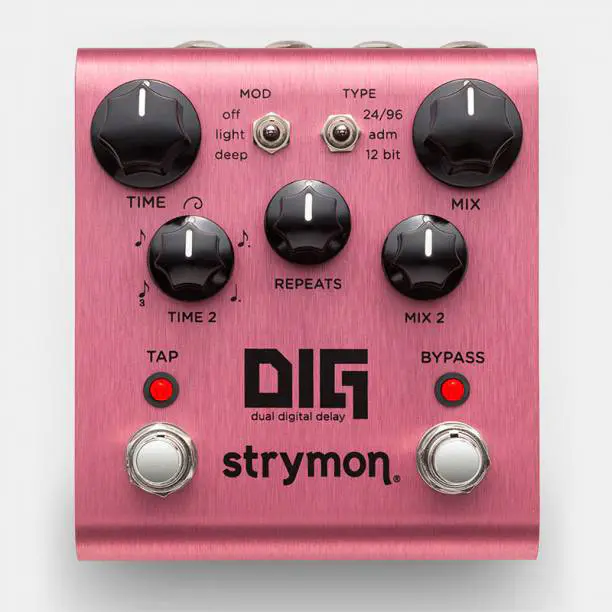
An homage to the digital rack delays of the ’80s, the Strymon Dig is a stereo, dual multitap delay offering three emulations of digital classics (ADM, 12-bit and 24/96) and two modulations modes (off, light and deep). Tap Tempo and subdivisions round up the features.
V2, released in 2022, adds a Tone knob and several upgrades to the circuit like full MIDI implementation, a JFET input circuit, and an ARM DSP chip that further improves the effect’s sound quality.
Each knob of the Dig can control a second parameter per, accessible by pressing both footswitches at once – see here for reference.
—
Here’s V1.

Strymon Dig, Builder’s Notes
Delay Doppelgänger.
DIG unearths the true soul of digital delay and doubles it—two simultaneous, integrated delays with the captivating rack delay voicings from the 1980s and today, for incredible expressive potential.Effortlessly create your own world of intricate and synchronized echoes, along with hypnotic and atmospheric repeats that blur the line between delay and reverb. Stretch your sonic horizons with five musically satisfying rhythmic subdivisions and three dual delay routing options. Go from syncopated, pulsating delay patterns, to evocative, spaced-out echo trails all in a compact, pedalboard-friendly format.
Rack to the Future.
Rack-mount digital delays of the ’80s ushered in a new era of audio effects. The innovative electronic designs generated the cleanest delays yet to be heard, but also created their own special and intriguing sonic characteristics. Thirty-plus years later, these sounds remain as distinctive and inspiring as ever.Classic Sound, New Features.
Our second generation DIG keeps the same distinctive rack-mount digital delay tones from our original and adds significant new features, incorporating technological advancements, hardware improvements and design enhancements to give you additional flexibility, power, and ease of use on stage and in the studio.Two Simultaneous, Integrated Delays.
DELAY 1 – The Master Delay.
Free-running delay time allows you to easily dial in delays from 20ms to 1.6s with the Time knob or Tap Tempo switch.Longer delay times lend themselves to more ambient soundscapes while doubling and slapback effects can be achieved at short delay times.
DELAY 2 – The Companion Delay.
Set the ratio between the two delays with one of five rhythmic subdivisions: triplet, eighth note, dotted eighth note, dotted quarter note, and the golden ratio.Don’t want synchronization? Engage Free Mode to disable subdivisions and allow Delay 2 to be its own independent, free-running delay. Dial in short delay times for chorus/flange sounds to run alongside Delay 1.
Voices Of Digital.
Don’t all digital delays sound the same? What gives a digital delay its own unique personality?
Digital conversion technologies in the late 70s were advancing rapidly, and clever electronics designers were on a quest to squeeze out the best possible performance specs, with fidelity not possible from tape or analog circuits. Their imaginative solutions to the limitations of the conversion process resulted in delays that possessed some unintended, unique characteristics. DIG accurately and beautifully reveals their individual personalities.
ADM – A one bit, high sample rate conversion technique that evolved from telecommunications voice coding. The conversion and supporting signal conditioning, limiting, and pre-emphasis/deemphasis create a percussive wide-band delay that adds more character when input dynamics increase.
12 bit – A 12 bit, 32kHz PCM conversion made possible by monolithic IC chips developed in the late ’70s. Pre-emphasis/de-emphasis and companding combine with the converters to produce a warm delay with a dimensional sense.
24/96 – A clean, high-resolution, high-bandwidth delay with a hint of dynamics that allow the delay to sit nicely with the analog dry signal. 24 bit resolution and a 96kHz sampling rate ensure uncolored, artifact-free repeats.
Midi Compatibility
Our new generation of DIG features full MIDI implementation, allowing you to control just about every switch, knob, and setting remotely by sending MIDI commands from your controller or DAW via DIG EXP/MIDI jack or USB-C connection. Delay times can be synchronized via MIDI Clock Sync, and the sync setting can be saved for each preset. 300 MIDI preset locations are available for loading and saving your favorite settings.
Remotely bypass or engage the pedal, sync delay time changes along with your tracks, automate knob adjustments, recall unique presets for each song on your setlist — the possibilities with MIDI are limitless.






















